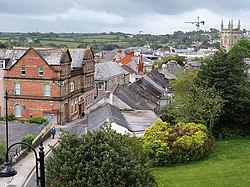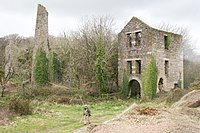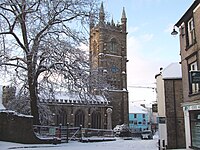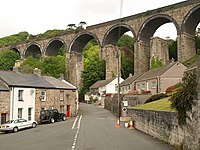St Austell: Difference between revisions
Created page with '{{Infobox town |name=St Austell |cornish= Austol |county=Cornwall |picture= High Cross Street, St Austell - geograph.org.uk - 1313370.jpg |picture caption=High Cross Street |lati…' |
|||
| (One intermediate revision by the same user not shown) | |||
| Line 85: | Line 85: | ||
* [http://www.oldcornwall.org/st_austell.htm St Austell Old Cornwall Society] | * [http://www.oldcornwall.org/st_austell.htm St Austell Old Cornwall Society] | ||
* [http://www.visitthecornishriviera.co.uk Cornish Riviera Tourist Information, St Austell] | * [http://www.visitthecornishriviera.co.uk Cornish Riviera Tourist Information, St Austell] | ||
{{DEFAULTSORT:Saint Austell}} | |||
Latest revision as of 00:15, 6 February 2013
| St Austell Cornish: Austol | |
| Cornwall | |
|---|---|
 High Cross Street | |
| Location | |
| Grid reference: | SX011524 |
| Location: | 50°20’17"N, 4°47’42"W |
| Data | |
| Population: | 22,658 (2001) |
| Post town: | St. Austell |
| Postcode: | PL25 |
| Dialling code: | 01726 |
| Local Government | |
| Council: | Cornwall |
| Parliamentary constituency: |
St Austell and Newquay |
St Austell is a major town in Cornwall. It is found on the south coast some ten miles south of Bodmin and 30 miles west of the River Tamar.
St Austell is the largest town in Cornwall according to the 2001 census, with a population of 22,658. Like much of Cornwall it was once a place where tin and copper mining prevailed, but its fame and wealth have come from the mining of Cornish china clay in and around the town.
History

John Leland in his Itinerary of the 1540s wrote that "At S. Austelles is nothing notable but the paroch chirch".[1]
Not long afterwards, William Cookworthy discovered china clay in Tregonning and the same mineral was found in greater quantity in the hills north of St Austell town.[2] Clay mining soon took over from tin and copper mining as the principal industry in the area, and this eventually contributed enormously to the growth of the town.
The clay industry really only came into its own during the mid 19th to early 20th century, at a time when the falling prices of tin and other metals forced many mines to close down or convert to clay mining. The success and high profitability of the industry attracted many families whose breadwinner had been put out of work by the depression in the local metal mining industry, and increased the population of the town considerably. This meant that more shops and businesses took root, providing more jobs and improving trade. This, along with other factors, led to St Austell becoming one of the ten most important commercial centres of Cornwall.
Economy
The china clay industry now employs only just over 2,000 people, a mere fraction of the workforce in the early 20th century, but the industry still achieves a higher annual output than ever before.
The town's economy is supported by its town centre shops and supporting businesses.
The St Austell Brewery, which celebrated its 150th anniversary in 2001, supplies cask ale to pubs in Cornwall and the rest of the United Kingdom. They are best known for their flagship beer, St Austell Tribute; a number of other ales are brewed but are rarely seen outside Cornwall. St Austell Brewery's original brewery 'The Seven Stars Inn' still stands today in the main town on East Hill.
Tourism

As in much of Cornwall and neighbouring counties, tourism is increasingly important to St Austell's economy. Tourists are drawn to the area by nearby beaches and attractions such as the Eden Project, sited in a former clay pit, and the Lost Gardens of Heligan. Summer visitors to the town make a big contribution to the local economy. The China Clay Country Park, in a former china-clay pit two miles north of the town, tells the story of the men, women and children who lived, worked and played in the shadow of the clay tips around St Austell.
St Austell is home to several public houses, numerous high street retailers, and several independent shops, many of which cater for tourists.
Churches

Parish church
The parish church was originally dedicated to St Austol, a Breton saint associated with St Meven, but is now dedicated to the Holy Trinity. By 1150 it had been appropriated to the Priory of Tywardreath by the Cardinhams, which continued until the priory was dissolved in 1535.
The remains of the original Norman church may be seen. The present church was built in the 15th century, a large building with an impressive tower. All four outside walls bear sculptural groups in carved niches: the Twelve Apostles in three groups on the north, east and south; the Holy Trinity above the Annunciation and below that the Risen Christ between two saints on the west. The tower can be dated to between 1478 and 1487 by the arms of Bishop Courtenay, and the walls are faced in Pentewan stone.[3]
On the south side of the church, a formerly separate chantry has been incorporated into the church when it was extended, the chantry itself having been abolished during the Henrician Reformation in 1543. There are "holy wells" at Menacuddle and Towan.[4] In the 19th century the following parishes were created out of St Austell parish: St Blazey (1845); Charlestown (1846, Treverbyn (1847), and Par (1846 out of St Blazey and Tywardreath).
Quakers
A Quaker Meeting House stands in the town, a plain granite structure built in 1829.
There was formerly a Quaker burial ground at Tregongeeves, just outside the town on the Truro Road. It was covered by about 6 feet of earth removed from the building of the new road in the 1960s. A high stone wall bounds the remaining acre of land; access can be gained through a wrought iron gate. About 40 of the headstones from Tregongeeves were removed and are now located at the Friends meeting house in the High Street in St Austell, just below the high wall which surrounds St Austell railway station. That meeing house is still in use.
Buildings of the town

Most of the shops on the old high street near the centre occupy original buildings. Notable Cornish architect Silvanus Trevail designed many of St Austell's buildings and houses, including the Thin End and the Moorland Road terrace (originally known as Work House Lane). Pevsner remarks in his guide to Cornwall that the following buildings are notable:[3]
- The Parish Church
- The Town Hall, in Italian Renaissance style, 1844
- Friends Meeting House, 1829, a plain granite structure
- White Hart Hotel (it once contained panoramic wallpaper of the Bay of Naples by Joseph Dufour et Cie which is now in the Victoria and Albert Museum)
- Holy Well at Menacuddle.
- Three buildings of the 1960s: Penrice School, 1960; Public Library, 1961; Magistrates' Court, 1966.
The Masonic Hall in South Street, had its cornerstones laid on the 20th June 1900, it is an outstanding building, with the apex crowned with a pentagonal star, various Masonic symbols abound the front, as well as the coat of arms of the United Grand Lodge of England.[5]
Freemasons
St Austell has a very large Masonic presence. The Masonic Hall in South Street is home to four Craft Lodges: Peace & Harmony Lodge No. 496 which was formed on 23 March 1844, and its three daughter Lodges established over the years: Tewington Lodge No. 5698, consecrated in March 1938; Carlyon Lodge No. 7392, consecrated in November 1955 and St Denys Lodge No. 8250, which was consecrated in January 1969.[6]
Other Masonic bodies meeting in St Austell are: Mount Edgcumbe Royal Arch Chapter No. 496, formed in 1874; Tewington Royal Arch Chapter No. 5698, formed on 11 November 1987; St Austell Mark Master Masons Lodge No. 275, consecrated on 22 February 1881; St Austell Lodge of Royal Ark Mariners No. 275, formed on 22 September 1962 and the St Austell Rose Croix Chapter No. 744, consecrated on 16 October 1973.[7]
References
- ↑ Leland, John (1964). "Part III". in Lucy Toulmin Smith. Leland's Itinerary in England and Wales. I. London: Centaur Press. pp. 202.
- ↑ Smith, John R. (1992). "Cookworthy and the Early Years". Cornwall's China-Clay Heritage. Twelveheads: Twelveheads Press/Cornwall Archaeological Unit. pp. 3. ISBN 0906294258.
- ↑ 3.0 3.1 Pevsner, N. (1970) Cornwall; 2nd ed. Penguin Books
- ↑ Cornish Church Guide (1925) Truro: Blackford; p. 57
- ↑ "Cryer, Revd N.B.,Masonic Halls of England: The South Shepperton: 1989, pp107-114"
- ↑ Williams, Richard Douglas, ed (October 2001). Thread of Gold: Celebrating the Unbroken History of 250 Years of Freemasonry in the Province of Cornwall. Truro: Cornwall Province of Freemasons. pp. 372. ISBN 978-0954085001.
- ↑ Cornwall Masonic Yearbook 2007/2008
Further reading
- Hammond, Joseph (1897) St Austell: being an account of St Austell, town, church, district and people. London: Skeffington & Son
- Rowse, A. L. (1960) St Austell: Church, Town, Parish. St Austell: H. E. Warne
Outside links
- St Austell Town Council
- Cornwall Record Office Online Catalogue for St Austell
- China Clay Country Park and Museum
- St Austell Old Cornwall Society
- Cornish Riviera Tourist Information, St Austell